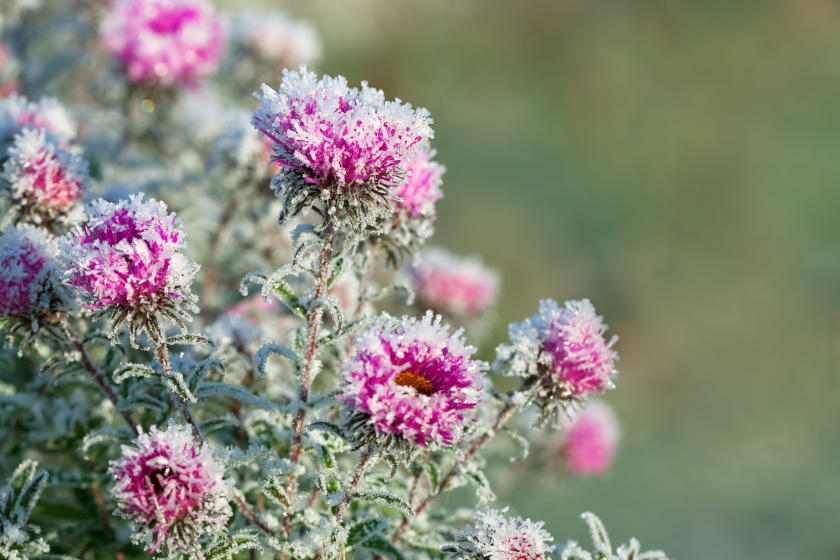Perennials are a fairly hassle-free way to enjoy colorful vegetation each year. Once they are planted, with the right care and attention, they come back every spring. As long as you put in a little work in the fall to prepare them for winter, they will give you stunning blooms when the weather warms.
Step 1: Plan Next Year’s Garden
Now is a good time to start planning for next year’s garden and to decide how your existing perennials will work with any annuals that you may plant in the coming spring or summer. Or perhaps you want to add more perennials to your garden or flower beds.
Keep a journal to track what you plant each year or to jot down ideas for future plantings. Note what worked together and what didn’t. You can even try mapping out next year’s garden by sketching out a basic diagram. Map the location of your perennials and how annuals and other perennials might work with them. If you’re going to be planting any flower bulbs for spring, you need to do it now.
Step 2: Cut Back Growth
While some perennials are evergreen, most survive the cold months by storing food reserves in their roots, tubers or bulbs. After the first frost, cut back perennial growth to just a few inches above the ground using a sharp hand pruner, garden shears or scissors. Leave the stems above ground to protect the crown — the part of the plant at ground level where the stem meets the roots — throughout the winter.
You may choose to leave certain perennials alone. Since they naturally begin to go dormant in late fall as they prepare for winter, some plants and grasses provide visual interest all year long. Take note of what kind of perennials you have in your garden. Try to understand their natural, annual cycles to decide whether you want cut them back or let them be.
Ornamental grasses usually remain attractive throughout the winter. Late-flowering, daisy-type perennials also remain attractive, such as: Rudbeckia and Purple Coneflower, Achillea, Agastache, Aster, Astilbe, Baptisia, Buddleia, Chelone, Cimicifuga, Eryngium and Eupatorium. It is up to you whether you want to cut them back or not.
It is a good idea to cut back perennials such as Alchemilla, Anemone, Campanula, Centaurea, Coreopsis, Delphinium, Dicentra, Euphorbia, Geranium, Hemerocallis, Hosta, Lychnis, Monarda, Nepeta, Oenothera, Phlox (tall types), Trollius and Veronica.
Evergreen perennials and alpines should not be trimmed in the fall. These include: Ajuga, Alyssum, Arabis, Armeria, Artemisia ‘Powis Castle’ and ‘Huntingdon’, Aubrieta, Aurinia, Bergenia, Cerastium, Corydalis, Dianthus, Epimedium (trim in late winter, before new buds appear), evergreen Euphorbia, Helianthemum, Helleborus, Heuchera, Iberis, Kniphofia, Lamium, Lavender, Liriope, Origanum, Phlox (creeping types), Primula, Pulmonaria, Sagina, Saxifraga, Sedum (many creeping types), Sempervivum, Teucrium, Thymus and Viola.
It’s best not to cut back these types of perennials as well: Buddleia, Caryopteris, Erysimum ‘Bowles Mauve’, Fuchsia, Hypericum, Lavatera, Perovskia (Russian Sage), Phygelius and Santolina.
Step 3: Clean Up
Make sure you thoroughly pick up any plant parts you cut back and any other plant debris that has died and fallen off. Remove any weeds and other garden debris as well, disposing of it in yard refuse bags. Leaving this organic matter in your garden could bring disease, insects and rodent infestation, as they are all attracted to decaying vegetation. After you’ve trimmed and cleaned is also a great time to edge your flower beds.
Step 4: Mulch
Mulch provides a layer of insulation from harsh winter temperatures and protects root systems from drastic changes in soil temperature caused by extreme freezing and thawing. This layer provides 5 to 10 degrees of temperature protection, which may mean life or death for certain plants.
Mulching your gardens and flowerbeds before the ground freezes and the snow starts will help your perennials survive the winter and bloom beautifully when warmer temperatures return.
There are different types of mulch available. While straw can be an effective and inexpensive cover, it may increase the chance of weed growth come spring. Wood chips are a good option but can be expensive. Pine needles are one of the most effective mulches, but they tend to be available only in certain parts of the country. You can also make your own shredded-leaf mulch by running over leaves with your mower, but dried leaf mulch is apt to blow away when the winter winds pick up. Cypress mulch is a familiar option and readily available in most regions of the country.
Whichever kind of mulch you choose, spread 4″ to 8″ of it in your garden with your hands. If your winters are especially harsh and temperatures are often well below freezing, you may even want to cover some plants completely. In areas where winters are milder, you can mulch around your perennials but do not cover them completely.
Step 5: Cover or Bring Inside
If you have perennials in planters, you can bring some species inside. They should be kept in a garage or shed. Many, however, need to stay outside in cold temperatures to kick-start their natural process of winter dormancy. Be sure you know how each species of plant behaves and what it requires for survival.
To cover plants, wrap them in a layer of burlap and loosely tie it to keep it secure.
Helpful Tip
Snow can actually be a good thing. Accumulated snow can add natural protection and warmth to your perennials and their sensitive structures below ground.
That’s it! You’re done. And your lawn and garden are ready for winter.
Project Shopping List
Here’s what you’ll need to complete this project successfully.
- Journal
- Graph paper
- Ruler
- Pencil
- Bypass pruner
- Garden shears
- Scissors
- Yard refuse bags
- Straw, wood chips, pine needles, shredded-leaf or cypress mulch
- Burlap
- Twine
- String










